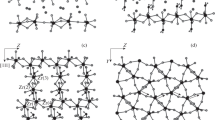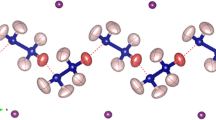Abstract
Purpose. Nedocromil sodium (NS), which is used in the treatment ofreversible obstructive airway diseases, such as asthma, has been foundto exist in the following solid phases: the heptahemihydrate, thetrihydrate, a monohydrate, an amorphous phase, which contains variableamounts of water, and a recently discovered methanol + water (MW)solvate. Our aim was to apply 13C solid-state nuclear magneticresonance (NMR) spectroscopy and solid-state Fourier transform infrared(FTIR) spectroscopy to the study of specific interactions in the varioussolid forms of NS.
Methods. The 13 solid-state NMR and FTIR spectra of the varioussolid forms of NS were obtained and were related to the crystalstructures of NS, the conformations of the nedocromil anion, and theinteractions of the water molecules in these crystals.
Results. The 13C solid-state NMR spectrum is sensitive to theconformation of the nedocromil anion, while the solid-state FTIR spectrumis sensitive to interactions of water molecules in the solid state. In NSmonohydrate, for which the crystal structure has not yet been solved,and in the amorphous phase, the information about the conformationsof the nedocromil anion and the interactions of the water moleculesare deduced from the 13C solid-state NMR spectra and solid-state FTIRspectra, respectively.
Conclusions. 13C solid-state NMR spectroscopy and solid-state FTIRspectroscopy are shown to be powerful complementary tools forprobing the chemical environment of molecules in the solid state,specifically the conformation of the nedocromil anion and the interactions ofwater-molecules, respectively.
Similar content being viewed by others
REFERENCES
H. G. Brittain (ed.). Polymorphism in Pharmaceutical Solids, Marcel Dekker, Inc., New York, 1999.
T. L. Threlfall. Analysis of organic polymorphs. Analyst. 120:2435–60 (1995).
C. Fyfe. Solid-state NMR for Chemists. C. F. C. Press, Guelph, Ontario, Canada, 1983.
M. C. Etter and G. M. Vojta. The use of solid-state NMRand X-ray crystallography as complementary tools for studying molecular recognition. J. Mol. Graphics 7:3–11 (1989).
D. Bugay. Solid-state nuclear magnetic resonance spectroscopy: theory and pharmaceutical applications. Pharm. Res. 10:317–32 (1993).
D. E. Bugay. Magnetic Resonance Spectrometry. In H. G. Brittain (ed.), Physical Characterization of Pharmaceutical Solids, Marcel Dekker, Inc., New York, 1995, pp. 93–126.
D. E. Bugay and A. C. Williams. Vibrational Spectroscopy. In H. G. Brittain (ed.), Physical Characterization of Pharmaceutical Solids, Marcel Dekker, Inc., New York, 1995, pp. 59–92.
D. A. Skoog and J. J. Leary. Principles of Instrumental Analysis, Harcourt Brace College Publishers, New York, 1992, pp. 252–295.
R. Khankari, L. R. Chen, and D. J. W. Grant. Physical characterization of nedocromil sodium hydrates. J. Pharm. Sci. 97:1052–1061 (1998).
H. Cairns, D. Cox, K. J. Gould, A. H. Ingall, and J. L. Suschitzky. New anti-allergic pyrano[3,2-g]quinoline-2,8,-dicarboxylic acids with potential for the topical treatment of asthma. J. Med. Chem. 28:1832–1842 (1985).
L. R. Chen, V. Young, B. E. Padden, E. J. Munson, and D. J. W. Grant. Structural and physicochemical characterization of a new mixed methanol 1 water solvate of nedocromil sodium. Pharm. Res. 14:S-202 (1997).
L. R. Chen. Solid-state Behavior of Pharmaceutical Hydrates. Ph.D Thesis, University of Minnesota, 1999, pp. 63–109, 110¶ 155.
A. A. Freer, D. W. Payling, and J. L. Suschitzky. Structure of nedocromil sodium: a novel anti-asthmatic agent. Acta Crystallog. C43:1900–1905 (1987).
R. K. Khankari, W. H. Ojala, W. Gleason, and D. J. W. Grant. Crystal structure of nedocromil sodium heptahemihydrate and its comparison with that of nedocromil sodium trihydrate. J. Chem. Crystallog. 25:863–70 (1995).
F. Gölles. The examination and calculation of thermodynamic data from experimental measurements. I. The numerical integration of the vapor-pressure curves of the system methanol-water. Monatsh. Chem. 92:981–991 (1961).
L. R. Chen and D. J. W. Grant. Effect of water vapor pressure on the dehydration kinetics of nedocromil sodium trihydrate. Pharm. Res. 13:S-356 (1996).
W. T. Dixon, J. Schaefer, M. D. Sefcik, E. O. Stejskal, and R. A. McKay. Total suppression of sidebands in CP/MAS 13C NMR. J. Magn. Reson. 49:341–5 (1982).
W. T. Dixon. Spinning-sideband-free and spinning-sideband only NMRspectra in spinning samples. J. Chem. Phys. 77:1800 (1982).
S. J. Opella and M. H. J. Frey. Selection of nonprotonated carbon resonances in solid-state nuclear magnetic resonance, J. Am. Chem. Soc. 101:5854–5856 (1979).
D. Lin-Vein, N. B. Colthup, W. G. Fateley, and J. G. Grasselli. The Handbook of Infrared and Raman Characteristic Frequencies of Organic Molecules, Academic Press, New York, 1991.
R. M. Silverstein, G. C. Bassler, and T. C. Morrill. Spectrometric Identification of Organic Compounds, John Wiley & Sons, New York, 1991, pp. 91–164.
M. Falk and P. Knop. Water in Stoichiometric Hydrates. In F Franks (ed.), Water, a Comprehensive Treatise, Vol. 2. Plenum Press, New York, 1973, pp. 55–113.
W. C. Hamilton and J. A. Ibers. Hydrogen Bonding in Solids. W. A. Benjamin, Inc., New York, 1968.
J. Kleeberg (ed.). Structure and Bonding. Springer-Verlag, Berlin, Heidelberg, 1988, pp. 97–125.
H. Brittain, D. Bugay, S. Bogdanowich, and J. DeVincentis. Spectral methods for determination of water. Drug. Dev. Ind. Pharm. 14:2029–2046 (1988).
G. Brink and M. Falk. Infrared studies of water in crystalline hydrates: LiI.3H2O. Can. J. Chem. 49:347–351 (1970).
H. Zhu, R. K. Khankari, B. E. Padden, E. J. Munson, W. B. Gleason, and D. J. W. Grant. Physicochemical characterization of nedocromil bivalent metal salt hydrates. 1. Nedocromil magnesium. J. Pharm. Sci. 85:10261–1034 (1996).
H. Zhu, J. A. Halfen, V. G. Young Jr., B. E. Padden, E. J. Munson, V. Menon, and D. J. W. Grant. Physicochemical characterization of nedocromil bivalent metal salt hydrates: 2. Nedocromil zinc. J. Pharm. Sci. 86:418–429 (1997).
W. H. Ojala, R. K. Khankari, D. J. W. Grant, and W. B. Gleason. Crystal structure and physical chemical properties of nedocromil zinc heptahydrate and nedocromil magnesium pentahydrate. J. Chem. Crystallog. 26:167–178 (1996).
H. Zhu, J. A. Halfen, V. G. Young Jr., B. E. Padden, E. J. Munson, V. Menon, and D. J. W. Grant. Physicochemical characterization of nedocromil bivalent metal salt hydrates: 3. Nedocromil calcium. J. Pharm. Sci. 86:1439–1447 (1997).
Author information
Authors and Affiliations
Rights and permissions
About this article
Cite this article
Chen, L.R., Padden, B.E., Vippagunta, S.R. et al. Nuclear Magnetic Resonance and Infrared Spectroscopic Analysis of Nedocromil Hydrates. Pharm Res 17, 619–624 (2000). https://doi.org/10.1023/A:1007533419711
Issue Date:
DOI: https://doi.org/10.1023/A:1007533419711




